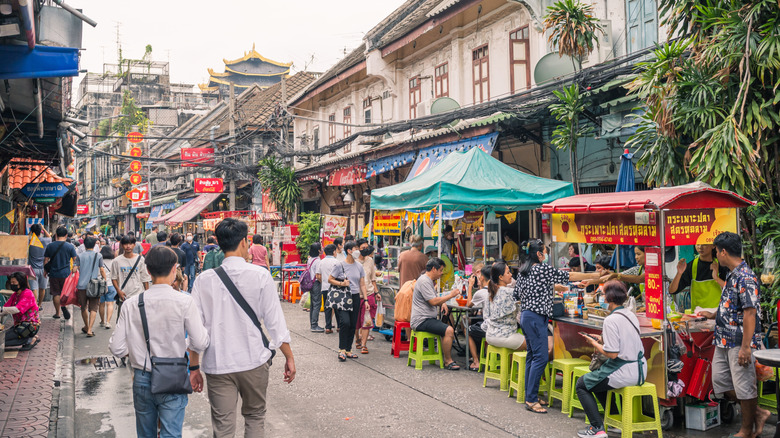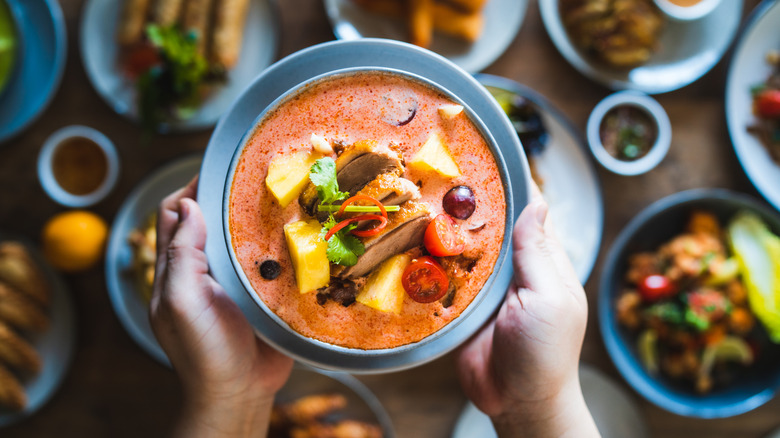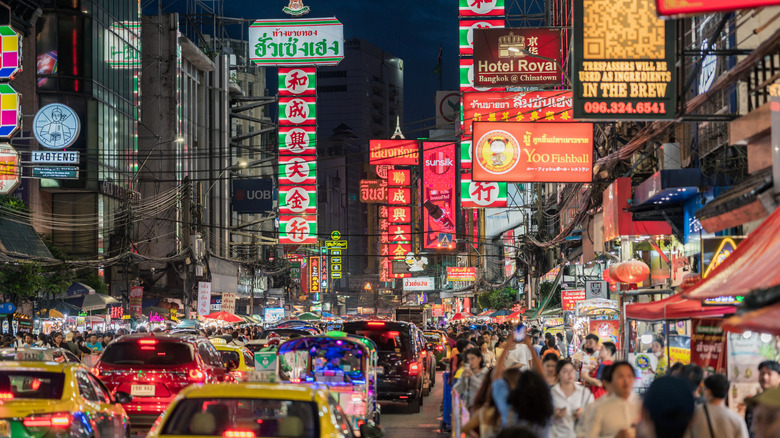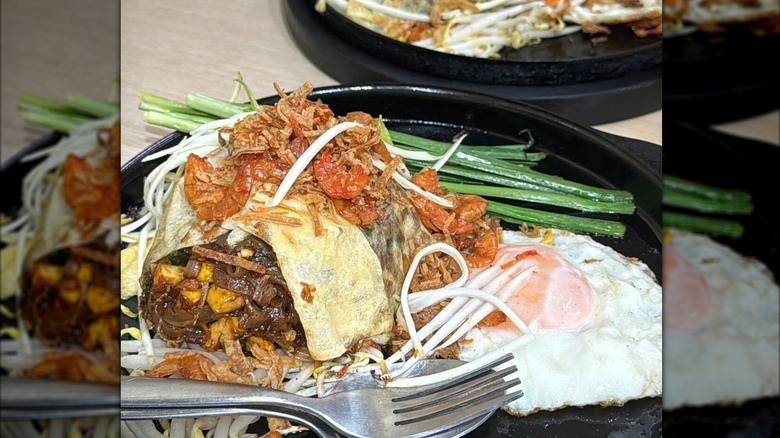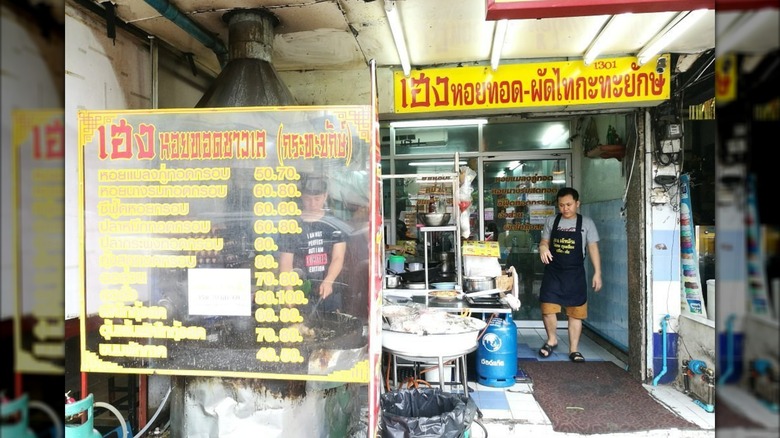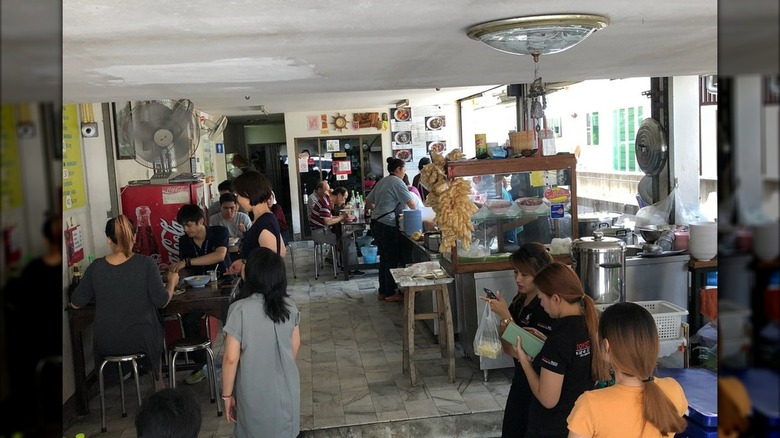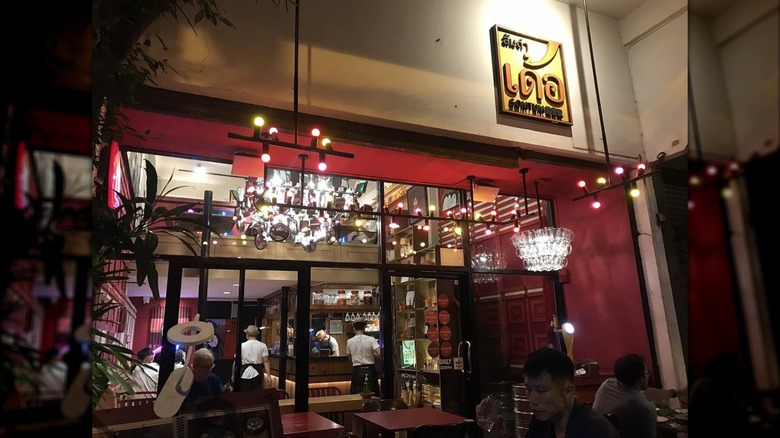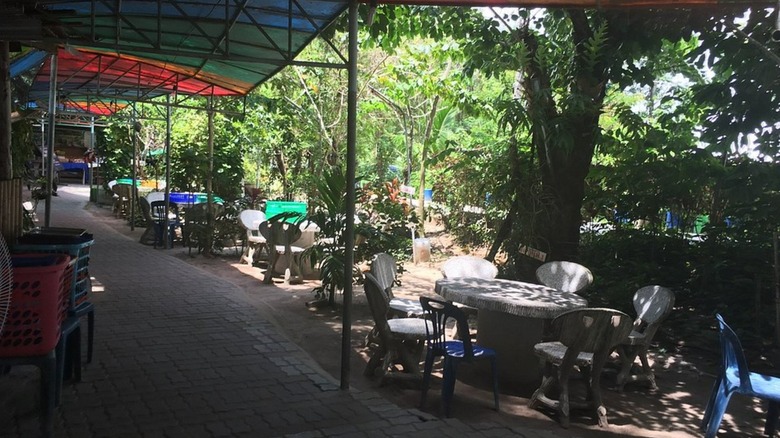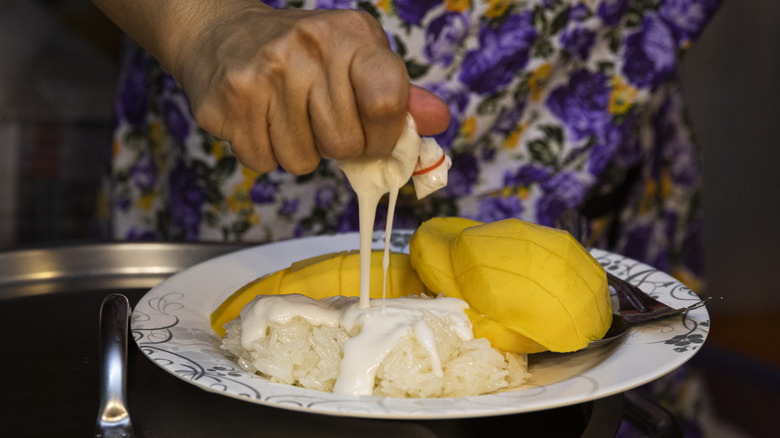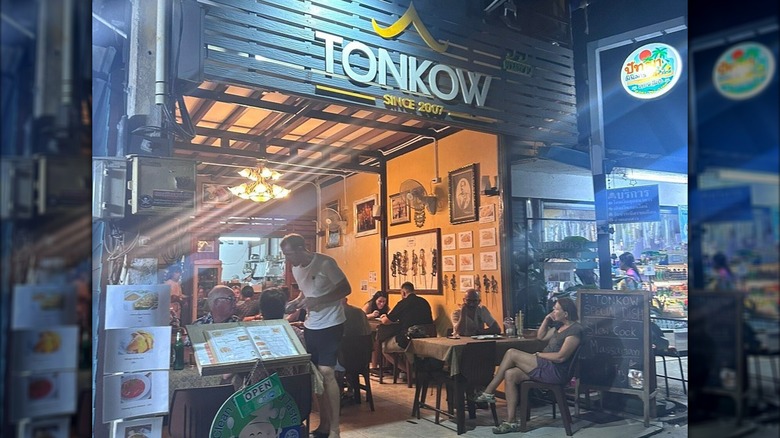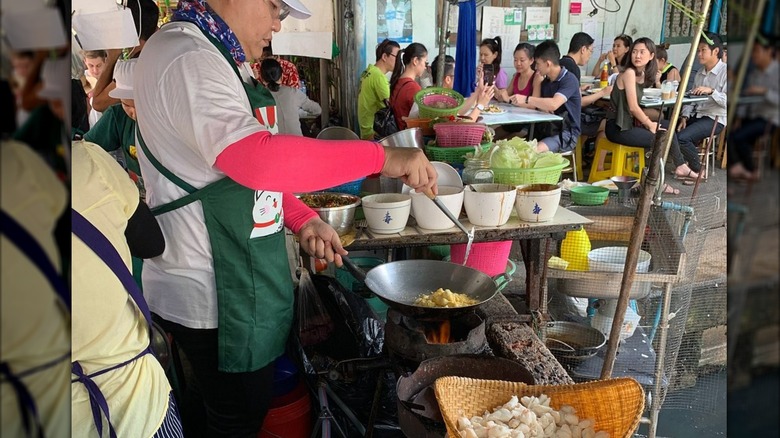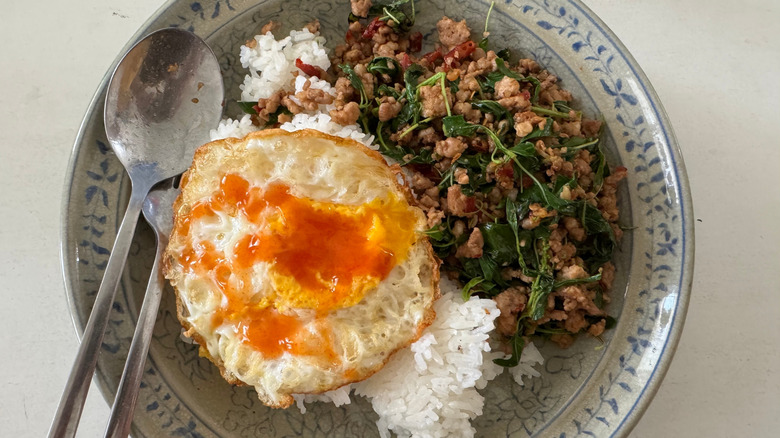Where To Find The Best Local Eats Across Thailand's Vibrant Food Scene
Thailand is a nation of unexpected customs and plenty of diversity. The Southeast Asian haven of vacation energy is perhaps most famous for its raucous capital city, Bangkok. The central urban landscape hums with excitement and acts as a great place to touch down when exploring Thailand on an extended getaway. There are plenty of things to know before vacationing in Thailand. One of them is certainly the value of branching away from your entry point into the marvelous and majestic country. Plenty of tourists will want to soak up the rays on a pristine Thai beach, but most will come, at least in part, for the legendary food scene. Thai food is well known the world over, and for good reason.
Whether you're planning to hit some of Thailand's best cultural sites and cities or one of the country's famous party islands, digging into the local eats is all a part of the fun. We connected with Katie Woodburn-Simmonds, an Asia travel expert at Simbur Travel, to get the lowdown on where and how to enjoy the best that Thailand's diverse flavors have to offer. "Make sure to do a food tour when you go to a city," she began. "The food scene in each Thai city is so immense, so deep and varied that you could spend years exploring it. Always get an expert to guide you to start with, ask loads of questions, ask about specific dishes or places that locals love. You can also just wander and get a seat anywhere that is busy at meal times, and you'll have a good time." These are some of her favorite picks.
What is the Thai culinary scene known for?
Thai food is wonderfully colorful, flavorful, and diverse. While many eaters who frequent Thai establishments in the diaspora will know (and almost certainly love) Pad Thai, there's a whole world of explosive flavor and spice to dig your teeth into while wandering around Thailand. "Thai people are either eating or thinking about eating. They are obsessed with food in the best possible way, and the result is that incredible food is everywhere and bad food is near impossible to find," Woodburn-Simmonds exclaims.
It's perhaps for this reason that Thailand's culinary diplomacy efforts have been so fundamentally transformative. Launched in 2002, the Global Thai program sought to reintroduce the world to this Southeast Asian country through offerings on the plate. Chefs were trained to deliver a Thai food experience across the world. Ultimately, it led to a groundswell of interest in visiting the country and eating authentic Thai food in the place it was conceived.
"Thai food is typified by big flavors, bold aromatics, and scorching chilies," according to Woodburn-Simmonds. Not everyone will be prepared for this depth of heat and aromatic nuance, so going at your own pace and easing into the experience may be warranted. Regardless, there's a lot to get excited about. She notes that "street stall owners serving up rice and noodles next to busy roads that will blow you away with the depth of flavor at extremely affordable prices. It feels like every street is filled with chefs who have mastered their craft and serve up perfect dishes with minimal space and equipment."
The best places to add to your itinerary for great eats
No two meals will ever be the same in Thailand. For many travelers, wandering around popular districts for street food options is a high priority, and in these places, you'll experience each chef's twist on classic recipes. However, Woodburn-Simmonds suggests traveling around the country to experience the breadth of its palate. "The food of Thailand is incredibly diverse; the best places to experience the diversity are Bangkok, Chiang Mai, and Phuket," she offers.
She adds that "Bangkok has food from all over Thailand, but a large amount of Central Thai dishes, which are lighter on spice and big on amazing seafood. Chiang Mai in the north is the centre of 'Lanna cuisine, influenced by the surrounding nations, where there are more grilled meats to go with the amazing curries. Phuket has the full mix of Southern Thai cuisine along with a heavy Chinese influence that is also found in Bangkok. You can find the searingly hot curries and soups of the South of Thailand, along with South Asian-influenced curry and roti, and Chinese-influenced noodle dishes. Oh, and more incredible seafood."
Travelers will also experience a whirlwind of authentic Thai food and a peppering of fusion dishes that combine influences from outside sources and cross-cultural diffusion. After all, Thai food isn't a monolith. Therefore, traveling across Thailand is necessary for those seeking an immersive food journey.
Pad Thai Narok Taek, Bangkok
No visit to Thailand would be complete without one key dish. That, of course, is Pad Thai, the iconic classic that every Thai food lover knows and probably seeks right after they get their passport back from the border agent. "Pad Thai — it's a cliché, but in all honesty, a well-made Thai is the platonic ideal of central Thai food," Woodburn-Simmonds says.
The dish has become the preeminent Thai experience for a reason. It hits all the essential flavor notes while bringing together amazing ingredients that make the plate sing. "Hot, sweet, sour, and salty in perfect balance. Pad Thai Narok Taek in Bangkok makes the best pad Thai in Thailand, and maybe the world, and I will die on that hill," claims Woodburn-Simmonds. There's lots to enjoy about a great Pad Thai, and eating one at perhaps the best restaurant for the dish in its authentic homeland brings a unique experience to your travels that just maybe will stand as the pinnacle culinary encounter of your adventure.
Heng Hoitod, Bangkok
Beyond being the capital city and a place of adventure that's perfectly suited to travelers of all sorts, Bangkok's food scene is brimming with amazing eats that run the gamut of stylistic layouts. There are street food vendors that deliver all kinds of amazing quick dishes, noodle options, and more. You will also find sit-down restaurants that elevate the experience in a different way. But right in the middle is the chain restaurant. At home, these might not provide much in the way of uniqueness, but when you head abroad, you can often find immensely great meals in these kinds of establishments (think ramen chains in Japan).
"Hoi Tod" is a great example highlighted by Woodburn-Simmonds. "It's not really a pancake, and it's not really an omelette. Hoi tod is oyster and mussels cooked on a flat top with a batter of rice and tapioca flour. Usually with some egg and bean sprouts on their top," she says. "The best are made with pork fat, though many use soybean oil instead. I love Heng Hoitod, there are a few branches in Bangkok."
Khao Soi Maesai in Chiang Mai: 'The best Khao Soi in the north'
Heading away from Bangkok, a trip up to the north of Thailand is a must for food lovers dreaming of an immersive menu to dig into. "A curry noodle dish from the North of Thailand that is rich, creamy, spicy, crunchy, chewy, and essentially all senses being hit at once," khao soi is a consummate winner for Woodburn-Simmonds.
The dish is "mostly made with chicken or beef, some restaurants do pork, seafood, vegetarian and vegan versions, too. Khao Soi Maesai in Chiang Mai is generally regarded as the best Khao Soi in the north," she adds. This is a change of pace for many eaters exploring Thailand for the first time. It's a regional specialty, and one that doesn't always get the love it deserves on a foreign Thai food menu. If you're looking for a fabulous and authentic meal, this is a rich and depth-filled selection that's sure to treat you well.
Somtum Der in Bangkok
Many Thai dishes feature influence from regional neighbors, and one that Woodburn-Simmonds recommends in particular gets its inspiration totally from abroad. This offers visitors a different kind of local food that's more about the country's culinary relationship with its neighbors and the very human elements of movement, sharing, and communal growth.
"Som Tum — Green Papaya salad — is a dish originating in Laos and now a favourite across most of Southeast Asia. The exact ingredients vary, but always green papaya and tomatoes in a sugar, lime, and chili dressing," she says. If you're wary of the spice level, you'll want to specify the heat to your chef or server while ordering. However, there's a handy way of dealing with this: Be assertive instead of bumbling through a conversation about spiciness. "Ask for the number of chilies you want in your salad: 1 for small spice, 7+ for very spicy," she notes. "Somtum Der in Bangkok serves many excellent variations of this salad and has a few branches."
Mor Mu Dong Restaurant in Phuket
Spice lovers can easily get behind a visit to this restaurant for a taste of a cracking, authentic meal. Woodburn-Simmonds suggests khua kling as a wonderful option for adventurous eaters. "Khua kling is Matt's [her husband] favorite Thai dish. A dry minced meat curry that is, usually, astonishingly spicy but can be made less so. It's a Southern dish, so the best are often found in Southern Thailand or Southern specialist restaurants. Mor Mu Dong restaurant in Phuket does an excellent khua kling."
Minced meat dishes are often packed with intense flavors that go far beyond the spices sitting on top of the taste profile. The aromatic and spice-driven flavors found in a khua kling will knock your socks off in all the best ways! This is also a great reason to branch out and explore more than just Bangkok. Moreover, Phuket is a tourist haven in its own right with plenty of great sights and sounds to take in. Just make sure you review some crucial travel tips specific to the seaside vacation destination before jetting off.
Look to the streets for a 'proper' mango sticky rice
Just about everyone who knows and loves Thai food will be familiar with mango sticky rice, even those who haven't had the privilege of tasting the dish. This isn't a particularly difficult meal to prepare, but there is a knack to finding a mind-blowing plate of the fruity stuff. Woodburn-Simmonds notes two specific features of a perfected mango sticky rice: the first is seasonality.
"Mango season in Thailand is late March to July, and this is the time for mango sticky rice," she says. Due to the global network of trade and a modern trend of year-round availability of many seasonal items, you may be able to find this dish in the winter or fall. However, the best version of a fresh mango dish is one that is locally sourced. If you're eating it outside of the ideal window for harvesting the fruit in Thailand, you're getting a preserved version or one that uses ingredients that came from far away and naturally won't be as fresh.
Regarding the second feature, Woodburn-Simmonds suggests hunting for a plate from particular sources. "Many street food vendors offer a good version of this," she notes. "The number one thing is making sure you're getting ripe mango and super sweet and sticky rice. Fancy hotel restaurants tend to do this very poorly."
Tonkow Restaurant on Koh Lipe for a change-up from typical Thai spice
Not every Thai dish has to involve a tremendous volume of chilies. Even visitors who can handle the spice might welcome a change of pace to give their mouths and digestive system a bit of a reprieve. For this alternative, Woodburn-Simmonds offers: "Massaman curry — A food lover who is worried about spice in Thailand's best friend."
Curries are a consistent theme throughout the Thai cuisine experience. The red and green curries, which pack in spice and vibrant color, are perhaps the most prominent offerings, but that's not the end of this story. Instead, Woodburn-Simmonds notes, "Massaman is rich and creamy, slow-cooked for incredible depth of flavor. It is usually served with delicious flaky roti, too. We love the version from Krua Aroy-Aroy in Bangkok, but also Tonkow restaurant on Koh Lipe does a phenomenal chicken massaman." Whether you're seeking a small break from intense heat or looking for a delicious alternative that avoids too much heat during an extended stay in the country, this is a must-taste choice.
Nhong Rim Klong and Raan Jay Fai in Bangkok
The crab omelet is a classic Thai dish. Crab is consistently found within the culinary repertoire of Thai chefs, and Woodburn-Simmonds luxuriates in the experience she had with two restaurants in Bangkok, in particular. "I feel like I could pick any of about six amazing crab dishes, but Thailand's omelette game is unmatched," she says. The omelet is a simple dish, but one that's a perfect delivery system for the juicy, meaty flavors of crab meat (much like butter on toast!).
Not only is this a great way to lap up a delectable meaty treat, but she adds: "The crab meat omelettes offer insane value compared to most of the West. You can queue for Jay Fai's astonishingly good version, but you will queue for hours. Alternatively, Nhong Rim Klong has amazing crab omelettes, which are amazing value." With this, she gives visitors a solid set of options. Those who don't mind waiting for the cream of the crop might opt to add the stunningly tasty meal to their taste buds' journey. Others with more places to be might consider grabbing a faster meal that still packs in value and flavor.
Skip the sit-down restaurant for a classic Pad Ka Prao
Another crucial Thai dish highlighted by Woodburn-Simmonds is the Pad Ka Prao. This one is very near to the hearts of many Thai people and makes for a revelatory eating experience for those seeking true Thai cuisine. "While Pad Thai is hailed as Thailand's 'national dish,' Pad Ka Prao is probably actually the national dish. It's meat or seafood stir-fried with holy basil (Thai basil), soy sauce, fish sauce, and chilies to create a rich and aromatic dish," she gushes.
Like many other Thai dishes, not every Pad Ka Prao you'll find will resonate with the same exuberant authenticity and shimmering flavor. "It is served over rice and often with a fried egg on top. You can find it almost anywhere on street stalls and in restaurants. It's extremely rare to find anyone doing a bad version," she notes, but suggests a particular aim for your Pad Ka Prao order for the best possible eats. "Avoid any 'fancy' versions, though; they aren't worth the extra money. Cheap and cheerful for the best flavor."
Make sure you're explicit about your spice level desires
Woodburn-Simmonds wasn't content to just deliver a laundry list of phenomenal local Thai food options throughout the most visited communities in the country. She offered some key insights about how to parse excellent plates from lackluster ones throughout our conversation. But she also made a special mention about tailoring your orders to your tastes. She was particularly focused on spice levels in this regard.
"The Thai people are extremely helpful and always want to ensure you enjoy the food. If you don't look Asian, they will assume you don't want spicy food," she said. This means that a foreigner exploring Thailand is likely to receive a purposefully less spicy variety of the chef's typical recipe whenever assembling a dish is a part of the process. This may be a welcome component of Thai hospitality for some, but it won't suit the needs and desires of everyone.
Thai people have built an appreciation and something of an immunity to spice through years of eating these dishes at full strength. Some foreigners who can handle that level of spice will seek a truly authentic, no-holds-barred culinary journey. "If you do want spicy food," she says, "then you have to really persuade them that you do. Either stating how many chilies you want in the dish — they predominantly use bird's eye chilies – or by saying 'ped ped.' The street food is generally very safe, too. Follow some basic safety steps, make sure the stand is busy, and you should be fine."
